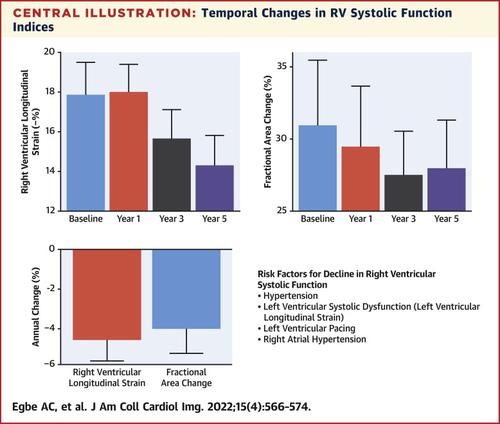JACC: Cardiovascular Imaging ( IF 12.8 ) Pub Date : 2021-11-17 , DOI: 10.1016/j.jcmg.2021.09.016 Alexander C Egbe 1 , William R Miranda 1 , C Charles Jain 1 , Heidi M Connolly 1

|
Objectives
The purpose of this study was to determine the risk factors for and prognostic implications of progressive right ventricular systolic dysfunction (RVD) in adults with congenitally corrected transposition of great arteries.
Background
There are no effective therapies for RVD; hence the need to identify and modify risk factors for progressive RVD.
Methods
RV systolic function was assessed by using RV longitudinal strain (RV-LS). The first echocardiogram (baseline echocardiogram) and all subsequent annual echocardiograms performed within 5 years from the baseline echocardiogram were analyzed. Progressive RVD (temporal decline in RV-LS) was assessed as the average annual change in RV-LS within 5 years of imaging follow-up.
Results
Of 186 patients (mean age 40 ± 12 years), the RV-LS at baseline was –17% ± 4%, and the annual decline in RV-LS was –4% (95% CI: –6 to –2). The risk factors for progressive RVD were left ventricular (LV) systolic dysfunction, LV pacing, and systemic hypertension. Cardiovascular events (heart failure hospitalization, heart transplant, and death) occurred in 57 (27%) patients. Progressive RVD was associated with cardiovascular events, independent of RV systolic function at baseline. In subgroup analyses assessing impact of therapies (medical therapy, cardiac resynchronization therapy, and tricuspid valve replacement), only tricuspid valve replacement was associated with improvement in RV systolic function when performed before onset of RVD.
Conclusions
Patients with congenitally corrected transposition of great arteries were at risk for progressive RVD, and the risk factors for progressive RVD were LV pacing, systemic hypertension, and concomitant LV dysfunction. Further studies are required to determine whether strict blood pressure control and early tricuspid valve replacement will prevent progressive RVD.
中文翻译:

先天性矫正大动脉转位进行性系统性心室功能障碍的预后意义
目标
本研究的目的是确定先天性矫正大动脉转位成人进行性右心室收缩功能障碍 (RVD) 的危险因素和预后影响。
背景
RVD 尚无有效疗法;因此需要确定和修改进行性 RVD 的风险因素。
方法
RV 收缩功能通过使用 RV 纵向应变 (RV-LS) 进行评估。分析了第一次超声心动图(基线超声心动图)和自基线超声心动图起 5 年内进行的所有后续年度超声心动图。进行性 RVD(RV-LS 的时间下降)被评估为影像学随访 5 年内 RV-LS 的平均年度变化。
结果
在 186 名患者(平均年龄 40 ± 12 岁)中,基线时的 RV-LS 为 –17% ± 4%,RV-LS 的年下降率为 –4%(95% CI:–6 至 –2)。进行性 RVD 的危险因素是左心室 (LV) 收缩功能障碍、左室起搏和全身性高血压。57 名 (27%) 患者发生心血管事件(心力衰竭住院、心脏移植和死亡)。进行性 RVD 与心血管事件相关,与基线时 RV 收缩功能无关。在评估治疗(药物治疗、心脏再同步化治疗和三尖瓣置换术)影响的亚组分析中,只有三尖瓣置换术在 RVD 发作前进行时与 RV 收缩功能的改善相关。
结论
先天性矫正性大动脉转位患者存在进行性 RVD 的风险,进行性 RVD 的危险因素是 LV 起搏、全身性高血压和伴随的 LV 功能障碍。需要进一步的研究来确定严格的血压控制和早期三尖瓣置换术是否可以预防进行性 RVD。









































 京公网安备 11010802027423号
京公网安备 11010802027423号